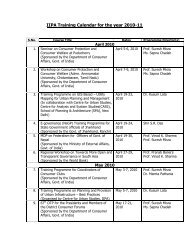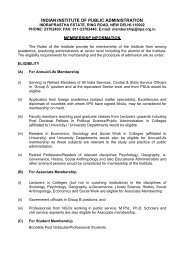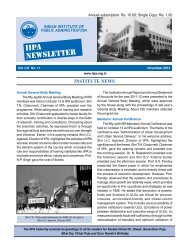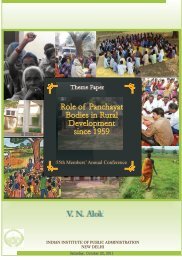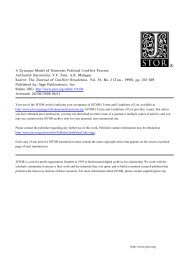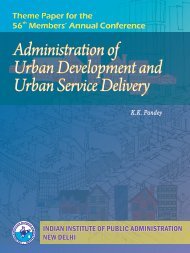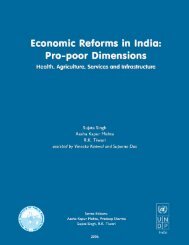Privatisation of Health Care in India - Indian Institute of Public ...
Privatisation of Health Care in India - Indian Institute of Public ...
Privatisation of Health Care in India - Indian Institute of Public ...
- No tags were found...
You also want an ePaper? Increase the reach of your titles
YUMPU automatically turns print PDFs into web optimized ePapers that Google loves.
Private <strong>Health</strong> Services <strong>in</strong> <strong>India</strong>: An Overviewneed to be <strong>in</strong>vested <strong>in</strong> the health sector <strong>in</strong> order to providehealth services across the country. In addition, the reportrecommended <strong>in</strong>vestment <strong>in</strong> the pharmaceutical sector <strong>in</strong>order to develop <strong>in</strong>digenous capabilities and reduce excessivereliance on the MNCs. The Bhore Committee, <strong>in</strong>1946, symbolised the <strong>India</strong>n state’s effort to plan and deliverhealth services, which would be accessible to all itscitizens. The period <strong>of</strong> the sixties reflected the real growthperiod <strong>of</strong> health services, but even at that time the <strong>in</strong>vestmentswere far from adequate. Thus, the Bhore committee’svision suffered a setback dur<strong>in</strong>g the sixties with most <strong>of</strong>the <strong>in</strong>vestment go<strong>in</strong>g <strong>in</strong>to the secondary and tertiary levels<strong>of</strong> care and primary health services rema<strong>in</strong><strong>in</strong>g weakly developed(Banerji, 1985; Qadeer, 1985).In terms <strong>of</strong> structure, the Bhore committee had envisioneda three-tier model with a strong primary health servicenetwork as a base and supported by secondary and tertiarylevels <strong>of</strong> care. In order to build an extensive network<strong>of</strong> services, the committee had suggested fairly high levels<strong>of</strong> <strong>in</strong>vestment <strong>of</strong> up to 12 percent <strong>of</strong> the GDP. Despitethe rhetoric <strong>of</strong> primary health care, the structure <strong>of</strong> provision<strong>in</strong>gwas largely curative, biased towards urban areasand <strong>in</strong> the secondary and tertiary levels <strong>of</strong> care. The structures<strong>of</strong> provision<strong>in</strong>g largely reflected the needs and aspirations<strong>of</strong> the middle classes from both urban and ruralareas that resulted <strong>in</strong> the growth <strong>of</strong> the secondary and tertiarylevels and the neglect <strong>of</strong> primary level <strong>of</strong> care.Several scholars have <strong>of</strong>ten criticised this and some haveeven questioned whether <strong>India</strong> can be characterised as be<strong>in</strong>ga ‘welfare state’ at all (Jayal, 1999). Despite the <strong>in</strong>crementalnature <strong>of</strong> health service plann<strong>in</strong>g, <strong>India</strong> did manageto build a fairly extensive network <strong>of</strong> services, created<strong>in</strong>digenous capacity for tra<strong>in</strong><strong>in</strong>g personnel for various levels<strong>of</strong> care and <strong>in</strong>vested <strong>in</strong> research and pharmaceuticalcapability. However, the low levels <strong>of</strong> <strong>in</strong>vestments <strong>in</strong> healthservices stunted the growth <strong>of</strong> the public sector, whichprovided the space for the growth and expansion <strong>of</strong> theprivate sector dur<strong>in</strong>g the last three decades. Apart fromthe grow<strong>in</strong>g presence <strong>of</strong> the private sector, the public sectorwas marked by rural/urban, regional and class <strong>in</strong>equalities.These trends were questioned dur<strong>in</strong>g the mid seventieswhen a progressive government was <strong>in</strong> power and setup a committee.The seventies were marked by a number <strong>of</strong> debates concern<strong>in</strong>gthe problems <strong>of</strong> health services development andsuggestions for change with<strong>in</strong> the country. Some <strong>of</strong> themwere seriously reviewed by national bodies and they wereextremely critical, but also <strong>of</strong>fered alternatives to remedysome <strong>of</strong> the problems (ICSSR/ICMR Committee report,1981) 1 . The reviews discussed the under-fund<strong>in</strong>g <strong>of</strong> the healthsector and the structural <strong>in</strong>equalities with<strong>in</strong> it. The critiquesemphasised the need for reorient<strong>in</strong>g health services to ruralareas and also to make medical education more relevant tothe needs <strong>of</strong> rural areas. However, the oil shock <strong>of</strong> the lateseventies had a negative impact on the f<strong>in</strong>ancial conditionand <strong>India</strong>, along with several other develop<strong>in</strong>g countries,found herself caught <strong>in</strong> the world recession. Due to thef<strong>in</strong>ancial crunch most third world governments dur<strong>in</strong>g theeighties were <strong>in</strong> no position to <strong>in</strong>crease <strong>in</strong>vestments <strong>in</strong> health.This meant stagnation <strong>in</strong> the growth <strong>of</strong> public services, whichwas an important reason for the growth <strong>of</strong> market forces<strong>in</strong> the health sector (Baru, 1998).The growth <strong>of</strong> the private sector and the gradual neglect<strong>of</strong> the public sector, have to be seen <strong>in</strong> terms <strong>of</strong> the changes<strong>in</strong> the social structure after Independence, <strong>in</strong> the rural/urbanareas and across regions <strong>in</strong> <strong>India</strong>. After Independencethe growth <strong>of</strong> the middle classes was not merely restrictedto urban areas. With agrarian prosperity as a result <strong>of</strong> thegreen revolution, there was a rise <strong>in</strong> the rich and middlepeasantry, who were largely drawn from the backwardcastes. This was ma<strong>in</strong>ly seen <strong>in</strong> some northern, western andsouthern states <strong>in</strong> the country (Kamat, 1985). These sectionshad made use <strong>of</strong> public <strong>in</strong>vestment <strong>in</strong> education as avehicle for social mobility <strong>in</strong> order to challenge traditionalsocial hierarchies. As a result, these upwardly mobile sections<strong>in</strong>vested heavily <strong>in</strong> the education <strong>of</strong> their children forsocial mobility and some <strong>of</strong> them, from the more prosperousareas <strong>of</strong> the country migrated to the UK and USAas qualified pr<strong>of</strong>essionals dur<strong>in</strong>g the late sixties and seventies(Baru, 1998; Omvedt, 1981; Khadria, 1999). Thus a1ICSSR/ICMR is the <strong>India</strong>n Council for Social Science Research and <strong>India</strong>n Council for Medical Research9




